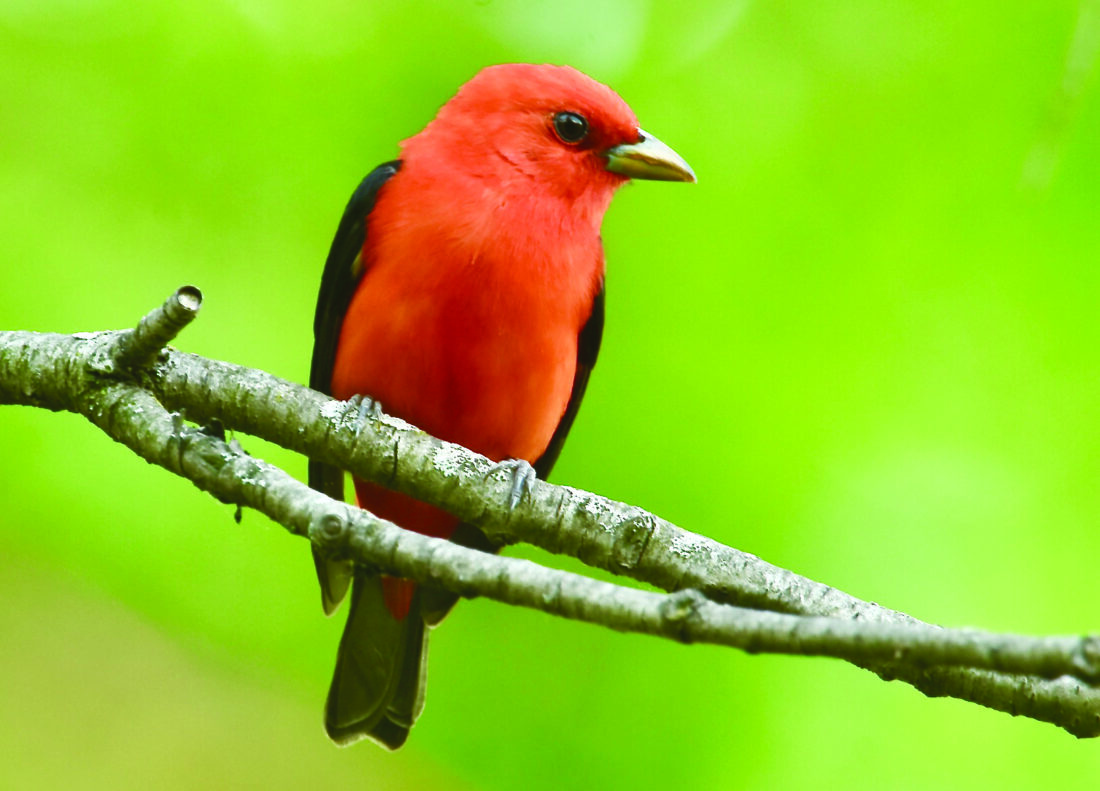What’s Flying: Birding and swimming a distinct pleasure

SCOT STEWART
“The month of August had turned into a griddle where the days just lay there and sizzled” – Sue Monk Kidd
They say where there is smoke there is fire. The fires certainly persist in Canada, with towns still getting evacuated as some fires continue to be difficult to contain. Summer smoke from these fires continues to be a problem for wildlife and humans alike. In particular, it may speed up some migrants.
Shorebirds are on the move. As far south as Oconto good numbers of yellowlegs and pectoral sandpipers are showing up along Lake Michigan as birds that unsuccessfully bred or lost their mates head south for the winter. At Whitefish Point ruddy turnstones, semipalmated sandpipers, and sanderlings have been seen briefly joining the summer resident piping plovers on the beach. The Point is a great spot to watch shorebirds – plovers and sandpipers, in the spring as quite a few will stop to forage for part of a day, often with young birds in tow. The new visitors, weary from crossing Lake Superior on their way down from the Arctic Tundra will attract merlins and migrating northern harriers and accipiters like sharp-shins, making for some lively activity.
There has been some shorebird activity at the Portage Marsh just south of Escanaba in Delta County. July 22 was a good day there for shorebirds. Ten killdeers were seen along with spotted sandpipers, lesser yellowlegs and two pectoral sandpipers. Several subsequent checks there since then have not turned up much for birders. This past Tuesday only one greater yellowlegs and a solitary sandpiper were seen, but seven trumpeter swans, three great egrets and two green herons were also seen with over 30 total species.
The really strong signs of waterbird fall migration can be found at the Cat Islands on the Lake Michigan shoreline north of Green Bay farther south in Wisconsin less than an hour from the U.P. border. The area is a restoration of a wildlife area with small islands and reefs washed away by storms and ice shoves. Currently there are over 200 acres of land and over 1200 acres of aquatic habitat for shorebirds, ducks, and other wildlife like wood and Blanding’s turtles.

A scarlet tanager looks on. (Scot Stewart photo)
Last Monday a birder checked a series of aquatic cells along a causeway and found an astounding number of birds there – nearly 3000 total. Nine species of ducks, including both scaup and ruddy ducks were seen along with 12 great egrets and 125 Caspian terns that nest there. Five bald eagles and two peregrine falcons and 220 yellow-headed blackbirds were found. Shorebirds were amazing – twelve species seen including rarer white-rumped and stilt sandpipers, 24 Wilson’s phalaropes and 25 short-billed dowitchers, all difficult to find in the U.P. but as these are migrating from the north or northwest regions of the U.S. and Canada, all are found in the U.P. at various times, usually during migrations. Portage Point, Peninsula Point at the tip of the Stonington, Whitefish Point, the mouth of the AuTrain River, and even the Lake Superior shoreline in Marquette are great places to look for these as they pass through.
A variety of tree and shrub fruits are currently ripening and are great places to watch for a number of late summer specials. Serviceberry fruits are near peak right now, especially along the Lake Superior shoreline in Marquette. The surprise with these trees is finding ring-billed gulls perched in the branches plucking fruits off. Pin cherries and honeysuckle berries are also ripe. They are great spots to look for cedar waxwings, young robins with their spotted chests, rose-breasted grosbeaks, Swainson’s and hermit thrushes, gray catbirds, and soon, tanagers and gray-cheeked thrushes. Woodpeckers are also surprise visitors to these trees, with northern flickers, red-bellied and even pileated woodpeckers feeding on the cherries. One of the best shows is seeing a whole family of pileated woodpeckers in a pin cherry tree plucking the tiny cherries off the slim branches.
It will still be three or four weeks until mountain ash berries are at least orange enough to draw the attention of the thrushes, catbirds and tanagers, but because the mountain ash crop looks to be substantial this year, there will be a lot of action in those trees. Even a variety of warblers, like Cape May and yellow-rumped could get into the berry picking action.
Long runways of thistles are also seeing their seeds mature. They are important stops for American goldfinches here during late summer as food, and few other birds venture to get into the thistles to feed, so there is little competition from other species for these seeds. These are very similar to the thistle or nyger seeds sold for bird feeders. Store seed is grown mostly in India and sterilized so it won’t grow here. Thistles can be quite obnoxious with their thorny stems and leaves and are a real problem for farmers but long stretches of them along roadsides and in fallow fields are important destinations for the goldfinches.
There are still a number of late nesters showing off newly hatched young birds, especially ducks and geese. One birder photographed a family of still very fuzzy young Canadas in Delta County this week. Another birder reported watching a family of mourning doves with young. They are quite similar to adults but are just smaller, with short tails. Much like pigeons, young are difficult to know when so much like adults.
Birding along the lake shore has been tougher with the heat drawing lots of human beach goers, but a few sandpipers have squeezed in between them making
- A scarlet tanager looks on. (Scot Stewart photo)
- SCOT STEWART


